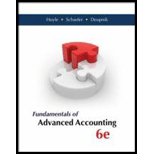
a.
Explain the manner in which Company A allocate Company S’s total acquisition-date fair value (January 1, 2015) to the assets acquired and liabilities assumed for consolidation purposes.
a.
Explanation of Solution
Company S’s total acquisition-date fair value (January 1, 2015) to the assets acquired and liabilities assumed for consolidation purposes:
| Particulars | Amount |
| Fair value of subsidiary on 01/01/13 | $ 1,750,000 |
| Book value of subsidiary on 01/01/13 | $(1,300,000) |
| Excess fair value over book value | $ 450,000 |
| Customer contract | $ (400,000) |
| $ 50,000 |
Table: (1)
b.
Show how the following amount on Company A’s pre-consolidation 2015 statements were derived:
- Equity in earnings of Company S
- Gain on revaluation of Investment in Company S to fair value
- Investment in Company S
b.
Explanation of Solution
Computation of Equity in earnings of Company S:
| Particulars | Amount |
| Net income in 2013 | $ 142,500 |
| Amortization in 2013 | $ (95,000) |
| Equity in earnings of Company S | $ 47,500 |
Table: (2)
Computation of Gain on revaluation of Investment in Company S to fair value:
| Particulars | Amount |
| Consideration transferred in 2012 | $ 184,500 |
| Income in 2012 | $ 15,000 |
| Dividends in 2012 | $ (4,500) |
| Book value as on 01/01/2013 | $ 195,000 |
| Fair value as on 01/01/13 | $ 262,500 |
| Gain on Revaluation | $ 67,500 |
Table: (3)
Computation of Investment in Company S:
| Particulars | Amount |
| Fair value as on 01/01/2012 | $ 262,500 |
| Consideration given on 01/01/2013 | $ 1,400,000 |
| Equity earnings in 2013 | $ 47,500 |
| Dividends in 2013 | $ (38,000) |
| Investment in Company S | $ 1,672,000 |
Table: (4)
c.
Prepare a worksheet to consolidate the financial statements of these two companies as of December 31, 2015.
c.
Explanation of Solution
The worksheet to consolidate the financial statements of these two companies as of December 31, 2015:
| Income statement | Company A | Company S | Debit | Credit | Non-controlling interest | Consolidated Balances |
| Revenues | ($931,000) | ($380,000) | S 200,000 | ($1,311,000) | ||
| Operating expense | $615,000 | $230,000 | E 100,000 | $945,000 | ||
| Equity in income of Company S | ($47,500) | $ - | I 47,500 | $ - | ||
| Revaluation gain | ($67,500) | $ - | ($67,500) | |||
| Net income | ($431,000) | ($150,000) | ||||
| Consolidated net income | ($433,500) | |||||
| Share of non-controlling interest in net income | ($2,500) | $2,500 | ||||
| Share of controlling interest in net income | ($431,000) | |||||
| | ||||||
| Current assets | $288,000 | $540,000 | $828,000 | |||
| Investment in Company S | $1,672,000 | $ - | D 38,000 | $1,235,000 | ||
| $47,500 | ||||||
| $427,500 | ||||||
| Property, plant and equipment | $826,000 | $590,000 | $1,416,000 | |||
| Patented technology | $850,000 | $370,000 | $1,220,000 | |||
| Customer contract | $ - | $ - | A 400,000 | E 100,000 | $300,000 | |
| Goodwill | $ - | A 50,000 | $50,000 | |||
| Total assets | $3,636,000 | $1,500,000 | $3,814,000 | |||
| Liabilities | ($1,300,000) | ($90,000) | ($1,390,000) | |||
| Common stock | ($900,000) | ($500,000) | $500,000 | ($900,000) | ||
| Additional paid-in capital | ($180,000) | ($200,000) | $200,000 | ($180,000) | ||
| | ($1,256,000) | ($710,000) | ($1,256,000) | |||
| Non-controlling interest in Company S | S $65,000 | |||||
| A $22,500 | ($87,500) | |||||
| ($88,000) | ($88,000) | |||||
| Total liabilities and equity | ($3,636,000) | ($1,500,000) | $1,935,500 | $1,935,500 | $3,814,000 |
Table: (5)
Working note:
| Statement of retained earnings | Company A | Company S | Debit | Credit | Non-controlling interest | Consolidated Balances |
| Retained earnings on 01/01 | $ (965,000) | $ (600,000) | $ 600,000 | $ (965,000) | ||
| Net Income | $ (431,000) | $ (150,000) | $ (431,000) | |||
| Dividends declared | $ 140,000 | $ 40,000 | D 38,000 | $ 2,000 | $ 140,000 | |
| Retained earnings on 31/12 | $(1,256,000) | $ (710,000) | $ (1,256,000) |
Table: (6)
Want to see more full solutions like this?
Chapter 4 Solutions
Fundamentals of Advanced Accounting
- What is the difference between a contra asset account and a liability?arrow_forwardJoe transferred land worth $200,000, with a tax basis of $40,000, to JH Corporation, an existing entity, for 100 shares of its stock. JH Corporation has two other shareholders, Ethan and Young, each of whom holds 100 shares. With respect to the transfer:a. Joe has no recognized gain. b. JH Corporation has a basis of $160,000 in the land.c. Joe has a basis of $200,000 in his 100 shares in JH Corporation. d. Joe has a basis of $40,000 in his 100 shares in JH Corporation. e. None of the above.arrow_forwardI need help with this general accounting problem using proper accounting guidelines.arrow_forward

 AccountingAccountingISBN:9781337272094Author:WARREN, Carl S., Reeve, James M., Duchac, Jonathan E.Publisher:Cengage Learning,
AccountingAccountingISBN:9781337272094Author:WARREN, Carl S., Reeve, James M., Duchac, Jonathan E.Publisher:Cengage Learning, Accounting Information SystemsAccountingISBN:9781337619202Author:Hall, James A.Publisher:Cengage Learning,
Accounting Information SystemsAccountingISBN:9781337619202Author:Hall, James A.Publisher:Cengage Learning, Horngren's Cost Accounting: A Managerial Emphasis...AccountingISBN:9780134475585Author:Srikant M. Datar, Madhav V. RajanPublisher:PEARSON
Horngren's Cost Accounting: A Managerial Emphasis...AccountingISBN:9780134475585Author:Srikant M. Datar, Madhav V. RajanPublisher:PEARSON Intermediate AccountingAccountingISBN:9781259722660Author:J. David Spiceland, Mark W. Nelson, Wayne M ThomasPublisher:McGraw-Hill Education
Intermediate AccountingAccountingISBN:9781259722660Author:J. David Spiceland, Mark W. Nelson, Wayne M ThomasPublisher:McGraw-Hill Education Financial and Managerial AccountingAccountingISBN:9781259726705Author:John J Wild, Ken W. Shaw, Barbara Chiappetta Fundamental Accounting PrinciplesPublisher:McGraw-Hill Education
Financial and Managerial AccountingAccountingISBN:9781259726705Author:John J Wild, Ken W. Shaw, Barbara Chiappetta Fundamental Accounting PrinciplesPublisher:McGraw-Hill Education





